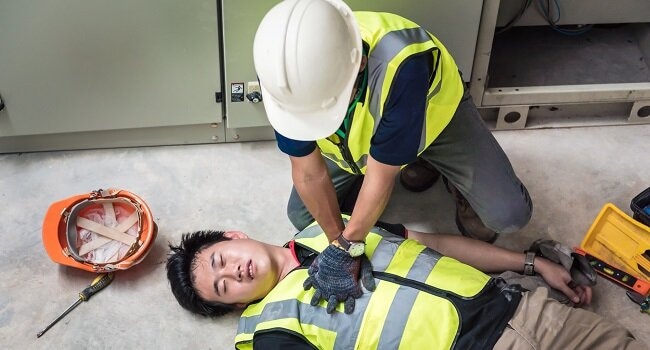Employees are the backbone of any organization. They function to deliver products to customers, manage operations and drive business success. That’s why ensuring their safety is paramount.
Although the modern workplace is safer than ever, you never know when an emergency like a workplace accident such as slips and falls, equipment injury, and other medical emergencies will happen. Knowing how to address them once they occur in the workplace and implementing preventive measures is imperative in ensuring proper emergency response and preventing workplace injury, allowing your business to continue to operate as usual.
This comprehensive guide for employers will explore how to handle workplace emergencies as they happen and how to prepare for them to ensure you’re responding appropriately. Read on.
How To Deal With Workplace Emergencies
Workplace emergencies may happen anytime. Therefore, it’s critical for you and your employees to know how to appropriately and immediately respond to such emergencies. To help you, here are some of the essential steps to take when dealing with workplace emergencies:
-
Stay Calm
In any emergency, it’s best to stay calm. When calm, you can think more clearly, responding more effectively and preventing the incident from escalating rapidly. That said, remind everyone to remain calm and take slow deep breaths.
Take a moment to assess the situation and determine the best action. Consider the potential risks and hazards of the problem. By staying calm, you can clearly remember the required emergency steps to take next.
-
Notify Emergency Services
Professional responders can help address any situation better. Call the emergency number immediately and provide as much information as possible so they can respond fast and efficiently. Staying on the line is crucial as the operator can provide you with the needed assistance. They may provide instructions on doing first aid if no certified responder is on the scene.
-
Provide Medical Assistance
If there are injuries, it’s vital to provide medical assistance and basic first-aid to anyone needing them. If there are certified first-aid responders available, then it might be time to put into practice what they have learned. If none, it’s best to wait for the emergency medical services (EMS).
-
Address The Cause Of The Emergency
Once the emergency is under control, investigate why it happened and address the cause of the emergency to prevent it from happening again. For example, if it’s an equipment injury, ensure the equipment has been turned off and its use suspended until further notice. Make sure to document the scene and accomplish an incident report. This will be vital for insurance purposes.
- Provide Support To The Injured Employee
If the injury is severe, the team member must be brought to the hospital for prompt medical attention. Provide the victim with time off from work. They must feel they can recover from their injury without fearing losing their job.
You may also provide your injured employee with proper accommodation, such as modified work responsibilities, workplace modification, and flexible work hours to help them return to their job as they try to recover wholly.

How To Prepare For A Workplace Emergency
It’s possible to prepare for an emergency to ensure the safety and well-being of your employees. However, it entails planning and detailed steps. It’s essential to follow this, so you know you’re ready anytime. Here are the steps you can take:
-
Conduct a Risk Assessment:
A risk assessment tool will help you identify potential hazards and risks in the workplace. Once you know this, you can develop a plan to address and reduce their effects.
When conducting a risk assessment, you must be as thorough as possible and check past incidents for reference. For example, in a restaurant kitchen, some hazards could be burns, slips and falls, and fire. You must be realistic and observe your team on the job. Because only by watching actual events can you give appropriate recommendations.
-
Develop an Emergency Plan:
The emergency plan outlines the steps to be followed in an emergency. Some practical elements of an emergency plan include each team member’s roles and responsibilities, communication methods, and procedures for assisting employees.
-
Install Safety Equipment:
A piece of safety equipment can help minimize the impact of an emergency. Some standard equipment required in most workplaces includes first aid kits and personal protective Equipment PPE. By having these in the workplace, you can be sure you’re providing your team with the necessary tools to help them mitigate the effects of emergencies.
-
Designate Emergency Responsibilities:
Preventing injuries in the workplace is everyone’s responsibility. It’s not just the job of one person. Everyone must contribute. Each team member must be assigned a specific duty. And as mentioned, this rotates at least every quarter. Some important roles you can give to your team include emergency response team, communication coordinators, and first aid responders.
-
Establish Communication Protocols:
In any emergency, employees must know who to contact. This is necessary so you can reach out to anyone, and they can reach you.
-
Provide First Aid Training:
First aid training is required in many industries. At least one certified first aid responder must be working in one location to ensure injuries are prevented and lives will be saved.
First aid training covers a vast range of topics, including CPR, how to use a defibrillator, how to use a bandage properly, wound care, choking and airway obstruction, burn management, and how to address poisoning. All these are crucial and can be used anytime in the workplace.
Preparing for workplace emergencies can help ensure your employees’ safety and well-being.
Conclusion
When not addressed properly and immediately, workplace emergencies such as slips and falls and injuries caused by defective tools and equipment malfunction can have severe consequences for your organization. As an employer, you must ensure your organization is well-prepared to respond to emergencies. That said, consider implementing the steps discussed above to improve safety in your workplace.




























